The Rice Water Haircare Market is estimated to be valued at USD 1.4 billion in 2025 and is projected to reach USD 3.1 billion by 2035, registering a compound annual growth rate (CAGR) of 8.1% over the forecast period.
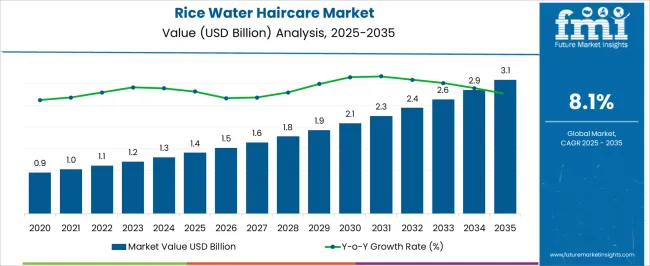
| Metric | Value |
|---|---|
| Rice Water Haircare Market Estimated Value in (2025 E) | USD 1.4 billion |
| Rice Water Haircare Market Forecast Value in (2035 F) | USD 3.1 billion |
| Forecast CAGR (2025 to 2035) | 8.1% |
The rice water haircare market is expanding steadily, driven by rising consumer demand for natural and traditional beauty remedies that are supported by scientific validation. Industry updates and product announcements have emphasized the benefits of rice water in improving hair strength, reducing breakage, and enhancing scalp health, which has resonated strongly with health-conscious consumers.
Growing preference for clean-label and chemical-free personal care products has elevated rice water formulations in mainstream and premium haircare lines. The market has also benefited from extensive digital marketing campaigns and endorsements through social media platforms, which have amplified consumer awareness globally.
Packaging innovations, particularly sustainable and recyclable formats, have further supported adoption by aligning with eco-conscious purchasing behaviors. Regional haircare traditions in Asia, combined with increasing global exposure, have positioned rice water as a trusted ingredient in hair wellness. Looking ahead, market expansion is expected to be fueled by continuous product diversification across shampoos, conditioners, and serums, rising adoption among younger demographics, and retail penetration through both e-commerce and organized retail channels.
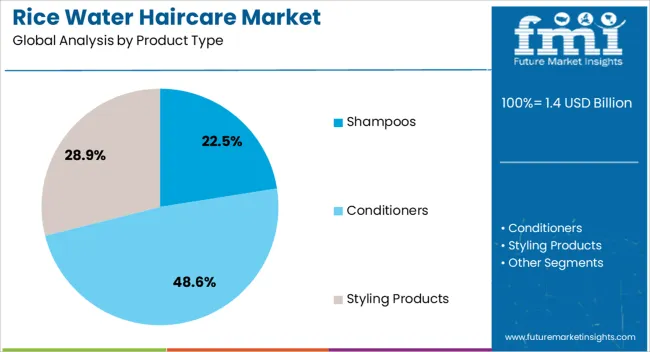
The Shampoos segment is projected to account for 22.5% of the rice water haircare market revenue in 2025, making it the leading product type. Growth has been driven by the segment’s widespread role in daily haircare routines, where consumers prioritize cleansing combined with functional benefits such as hair strengthening and scalp nourishment.
Rice water shampoos have been integrated into product portfolios by both mass-market and premium brands, reflecting their growing acceptance as natural alternatives to synthetic formulations. Frequent use of shampoos compared to other product types has ensured steady consumption patterns, supporting revenue leadership.
Additionally, innovations in sulfate-free, pH-balanced, and fortified rice water shampoos have improved market appeal across different consumer groups. With growing consumer trust in natural ingredients and the rising demand for multifunctional cleansing products, the Shampoos segment is expected to sustain its leadership in the rice water haircare category.
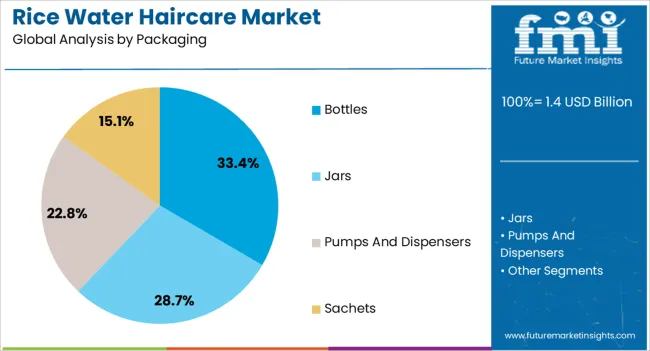
The Bottles segment is projected to hold 33.4% of the rice water haircare market revenue in 2025, maintaining its position as the preferred packaging format. The dominance of this segment has been attributed to its convenience, durability, and compatibility with a wide range of liquid formulations.
Manufacturers have favored bottles for their cost-effectiveness in large-scale production and their ability to accommodate different product sizes. Consumer preference for bottles has been further reinforced by their resealability and ease of handling during regular use.
Moreover, the growing shift toward recyclable and eco-friendly bottle materials has aligned with sustainability goals, strengthening consumer confidence in packaged rice water haircare products. With continued advancements in lightweight and biodegradable plastics, as well as glass packaging options for premium lines, the Bottles segment is expected to retain its stronghold in the market.
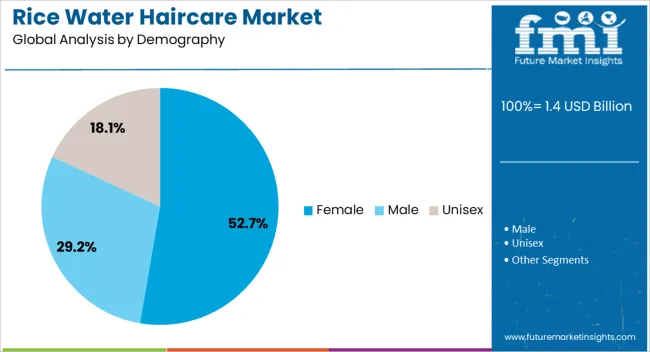
The Female segment is projected to contribute 52.7% of the rice water haircare market revenue in 2025, sustaining its role as the leading demographic group. Growth in this segment has been driven by the higher adoption of haircare products among women, supported by stronger engagement with beauty and wellness trends.
Consumer studies have highlighted women’s heightened preference for natural, restorative formulations that target issues such as hair thinning, frizz control, and scalp sensitivity. Marketing campaigns have been primarily directed toward female consumers, leveraging beauty influencers and celebrity endorsements to build trust and brand loyalty.
Additionally, product ranges tailored to women’s diverse hair types, from straight to curly, have increased the penetration of rice water-based offerings. As awareness of traditional beauty remedies continues to merge with modern wellness trends, the Female segment is expected to dominate, reinforced by consistent purchasing power and willingness to experiment with innovative haircare solutions.
The scope for rice water haircare products rose at a 7.6% CAGR between 2020 and 2025. The global market is achieving heights to grow at a moderate CAGR of 8.2% over the forecast period 2025 to 2035.
The market saw a steady growth during the historical period, attributed to the factors including growing concerns about harmful effects of synthetic chemicals. Influencers and beauty bloggers played a significant role in promoting rice water as a DIY hair treatment and as an ingredient in commercial haircare products.
Social media platforms served as powerful marketing channels, fuelling consumer interest and adoption of rice water based haircare solutions. Haircare brands innovated by introducing a wide range of rice water based products, including shampoos, conditioners, masks, and styling treatments.
Innovations such as encapsulation techniques and nanotechnology will enhance the delivery of active ingredients, and improving product performance and efficacy. The adoption of data analytics as well as artificial intelligence is projected to enable personalized haircare solutions tailored to individual needs and preferences.
Anticipated consumer preferences for sustainability and ethical sourcing will propel the demand for rice water based haircare products with eco-friendly packaging and responsibly sourced ingredients.
Brands that prioritize sustainability and transparency in their supply chain practices may gain a competitive edge in the market. Products targeting specific hair concerns such as scalp health, hair loss prevention, and anti-aging are forecasted to gain traction among health conscious consumers.
| Country | The United States |
|---|---|
| CAGR through 2035 | 4.2% |
The rice water haircare market in the United States will expand at a CAGR of 4.2% through 2035. Asian beauty practices, including the use of rice water for hair and skincare, have gained popularity in the country. Influenced by K beauty and J beauty trends, American consumers are embracing traditional Asian ingredients and rituals, contributing to the growth of the rice water haircare market.
Consumers in the United States increasingly prefer natural and organic haircare products due to concerns about the potential harmful effects of synthetic ingredients. Rice water, known for its natural nourishing and strengthening properties, aligns with this trend, accelerating the demand for rice water based haircare products.
| Country | The United Kingdom |
|---|---|
| CAGR through 2035 | 3.8% |
The rice water haircare market in the United Kingdom to expand at a CAGR of 3.8% through 2035. The country has a diverse population with varying hair types, textures, and styling preferences. Rice water based haircare products cater to the needs of consumers with different hair concerns, including dryness, damage, and frizz.
Social media platforms play a significant role in promoting rice water haircare products to consumers of the country. Influencers, beauty bloggers, and content creators share informative content, tutorials, and endorsements on platforms like Instagram, YouTube, and TikTok.
| Country | China |
|---|---|
| CAGR through 2035 | 13.3% |
Rice water haircare trends in China are taking a turn for the better. A 13.3% CAGR is forecast for the country from 2025 to 2035. The booming e-commerce market in the country provides a vast platform for brands to reach consumers nationwide.
Online retail giants offer extensive product selections and marketing opportunities for rice water haircare brands. Traditional Chinese medicine emphasizes the use of natural ingredients for holistic health and wellness. Rice water aligns with the traditional Chinese medicine principles and is valued for its nourishing and strengthening properties.
| Country | Japan |
|---|---|
| CAGR through 2035 | 7.8% |
The rice water haircare market in Japan is poised to expand at a CAGR of 7.8% through 2035. Japanese consumers have high standards for product quality, safety, and efficacy.
Brands that prioritize quality control, research, and development, and adhere to rigorous standards gain consumer trust and loyalty in the competitive Japanese market.
Japan is known for its advancements in cosmetic formulations and technology. Haircare brands in Japan innovate to develop rice water based products with advanced formulations, specialized benefits, and cutting edge delivery systems.
| Country | India |
|---|---|
| CAGR through 2035 | 9.7% |
The rice water haircare market in India will expand at a CAGR of 9.7% through 2035. Endorsements by celebrities and influencers significantly impact consumer purchasing behavior in India.
Celebrity endorsements of rice water haircare products, along with influencer testimonials and recommendations, help drive product awareness and credibility among Indian consumers.
There is a growing trend among Indian consumers to prioritize hair growth and lengthening. Rice water is believed to promote hair growth and strengthen hair follicles, making rice water based haircare products particularly appealing to individuals seeking to enhance hair length and volume.
The below table highlights how shampoo segment is leading the market in terms of product type, and will account for a share of 22.5% in 2025. Based on packaging type, the bottles segment is gaining heights and will to account for a share of 33.4% in 2025.
| Category | Shares in 2025 |
|---|---|
| Shampoo | 22.5% |
| Bottles | 33.4% |
Based on product type, the shampoo segment will dominate the rice water haircare market. Rice water based shampoos are generally gentle and suitable for all hair types, including dry, damaged, and sensitive hair.
Their mild cleansing properties make them ideal for daily use without stripping the hair of its natural oils, catering to diverse consumer preferences and needs. Shampoos formulated with rice water offer dual benefits of cleansing and nourishing the hair and scalp.
Rice water effectively removes impurities, excess oil, and product buildup from the hair while delivering vitamins, minerals, and amino acids that promote hair strength and vitality.
In terms of packaging type, the bottles segment will dominate the rice water haircare market. Bottles equipped with user friendly dispensing mechanisms, such as flip caps, pump tops, or squeeze bottles, facilitate easy and controlled product dispensing and application.
Consumers can dispense the desired amount of product with precision, minimizing wastage and ensuring efficient use of the haircare product.Bottles provide effective protection and preservation of rice water based formulations, helping maintain product integrity and efficacy over time.
Opaque or tinted bottles shield products from light exposure, while airtight seals and pump dispensers prevent contamination and oxidation, prolonging shelf life and product freshness.
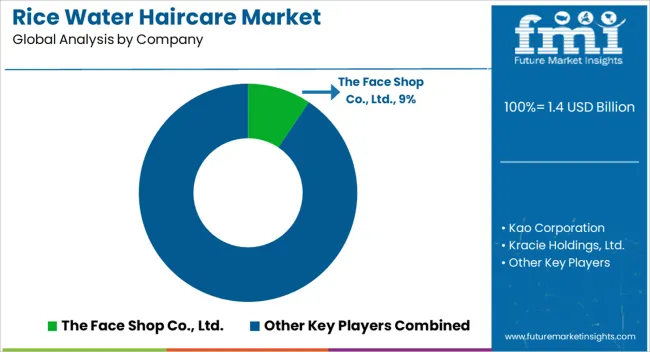
The rice water haircare market is characterized by a diverse array of players, including multinational corporations, established brands, emerging startups, and niche players, all vying for market share in an increasingly competitive industry.
Company Portfolio
| Attribute | Details |
|---|---|
| Estimated Market Size in 2025 | USD 1.4 billion |
| Projected Market Valuation in 2035 | USD 3.1 billion |
| Value-based CAGR 2025 to 2035 | 8.1% |
| Forecast Period | 2025 to 2035 |
| Historical Data Available for | 2020 to 2025 |
| Market Analysis | Value in USD Billion |
| Key Regions Covered | North America; Latin America; Western Europe; Eastern Europe; South Asia and Pacific; East Asia; The Middle East & Africa |
| Key Market Segments Covered | Product Type, Packaging, Demography, Sales Channel, Region |
| Key Countries Profiled | The United States, Canada, Brazil, Mexico, Germany, France, France, Spain, Italy, Russia, Poland, Czech Republic, Romania, India, Bangladesh, Australia, New Zealand, China, Japan, South Korea, GCC countries, South Africa, Israel, |
| Key Companies Profiled | The Face Shop Co. Ltd.; Kao Corporation; Kracie Holdings, Ltd.; Aveda Corporation; L'Oréal S.A.; Unilever PLC; Shiseido Company, Limited; Amorepacific Corporation; The Procter & Gamble Company; Davines S.p.A.; Organix Brands, Inc.; Giovanni Cosmetics, Inc.; Briogeo Hair Care LLC; Shea Moisture; Ouai Haircare |
The global rice water haircare market is estimated to be valued at USD 1.4 billion in 2025.
The market size for the rice water haircare market is projected to reach USD 3.1 billion by 2035.
The rice water haircare market is expected to grow at a 8.1% CAGR between 2025 and 2035.
The key product types in rice water haircare market are shampoos, _non-conditioning, _conditioning, _dry, conditioners, _rinse off, _leave on, _serums, styling products, _gels, _sprays, _mousses, _lotion, _waxes, hair color products, _hair dyes, _bleaching agents, _perms and relaxers, _hair oil, mask and serums and _hair loss treatment products.
In terms of packaging, bottles segment to command 33.4% share in the rice water haircare market in 2025.






Full Research Suite comprises of:
Market outlook & trends analysis
Interviews & case studies
Strategic recommendations
Vendor profiles & capabilities analysis
5-year forecasts
8 regions and 60+ country-level data splits
Market segment data splits
12 months of continuous data updates
DELIVERED AS:
PDF EXCEL ONLINE
Key Players & Market Share in Rice Water Haircare Sector
Rice Shampoo Bar Market Size and Share Forecast Outlook 2025 to 2035
Rice Bran Oil for Skin Care Market Size and Share Forecast Outlook 2025 to 2035
Rice Bran Oil Infusions Market Analysis - Size and Share Forecast Outlook 2025 to 2035
Rice Milling Machine Market Size and Share Forecast Outlook 2025 to 2035
Rice Bran Derivatives Market Size and Share Forecast Outlook 2025 to 2035
Rice Mill Machine Market Size and Share Forecast Outlook 2025 to 2035
Rice Derivative Market Size and Share Forecast Outlook 2025 to 2035
Rice Polishing Machines Market Size and Share Forecast Outlook 2025 to 2035
Rice Bran Oil Market Analysis by Type, End User, and Region Through 2035
Rice Processing Machine Market Size and Share Forecast Outlook 2025 to 2035
Rice Bran Wax Market Analysis - Size, Share, and Forecast 2025 to 2035
Rice Cake Market Analysis - Size, Share, and Forecast Outlook 2025 to 2035
Rice Milk Market Trends - Dairy-Free Nutrition & Industry Growth 2025 to 2035
Rice-based Products Market Analysis by Product Type, Distribution Channel, and Region Through 2035
Market Share Breakdown of Rice Shampoo Bar Manufacturers
Rice Paper Stand Up Pouch Market Growth & Sustainable Packaging 2024-2034
Rice Protein Market
Rice Water Skincare Market Forecast and Outlook 2025 to 2035
Rice Water Shampoo Market Size and Share Forecast Outlook 2025 to 2035

Thank you!
You will receive an email from our Business Development Manager. Please be sure to check your SPAM/JUNK folder too.
Chat With
MaRIA